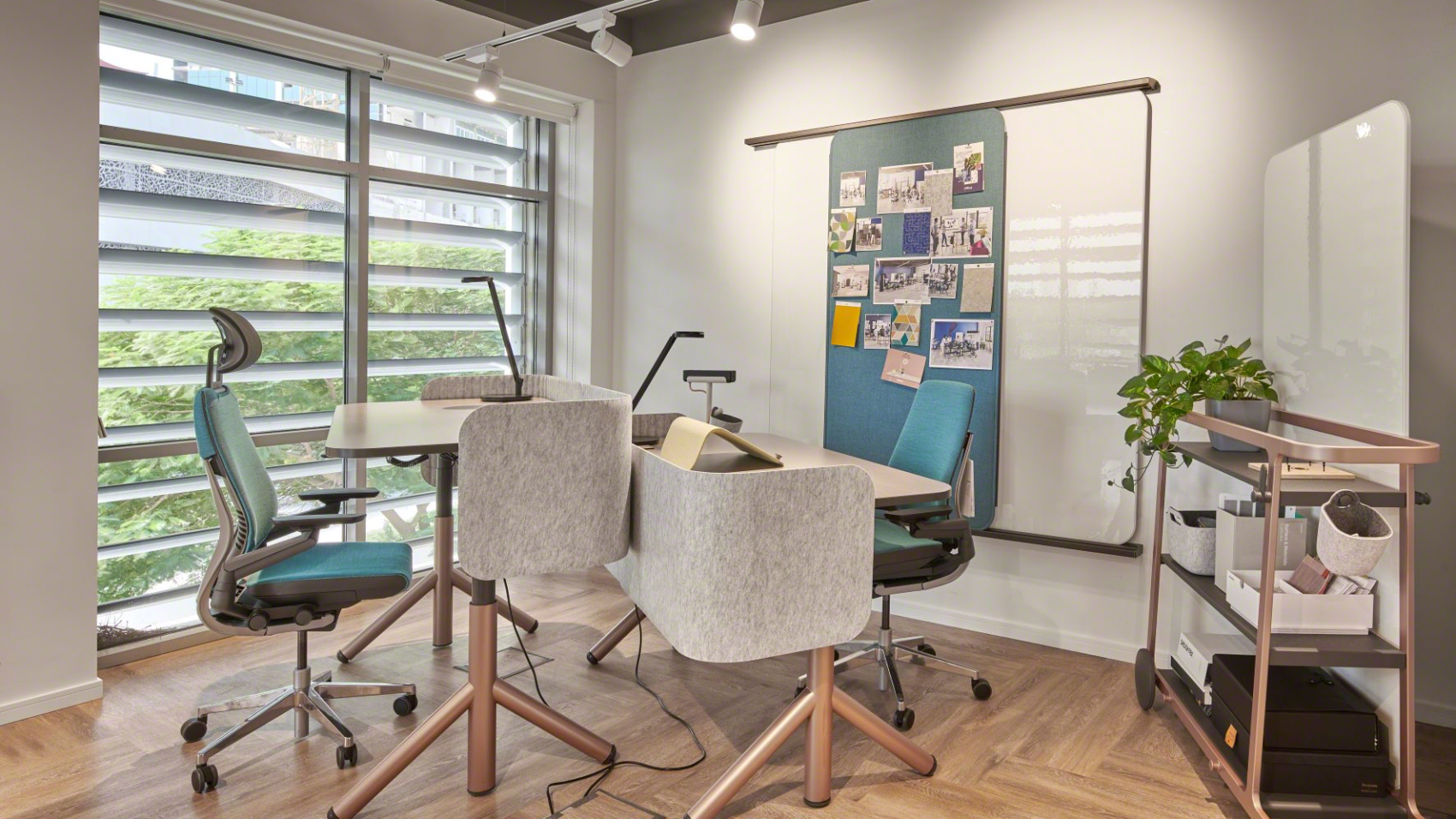The earlier you bring design, facilities and IT together to consider how furniture, lights, video and audio will intersect, the more seamless the hybrid collaboration experience will be for in-person and remote participants.
1. Consider the rooms layout so everyone faces the camera.
That may mean shifting orientation to the long wall instead of the short wall in a rectangular room. Seating in arcs or orienting everyone to face the camera helps improve communication, eye contact and focus. Tiered seating in larger spaces can help everyone’s face be seen on camera. Includes plenty of personal tables for individual devices. In the open, consider seating with a high back or a built-in screen for added privacy. Furniture with pegs, hooks and storage keeps cords, personal belongings, and equipment out of the way.
2. In enclosed spaces, center the camera in the room to ensure everyone at the table is in the field of view.
Avoid excessive on-video motion and distraction by eliminating pathways around the space from the camera’s view. Privacy film can be applied to glass to hide what’s happening on the screen from passersby. In open spaces, position the camera to avoid views of aisles, corridors, or adjacent co-workers. Conversations and movement will be distracting.

3. Focus on speech clarity and privacy, as well as limiting the spread of sound, atmospheric noise, and echoes.
Fabric wall treatments, panels, carpet, and softer seating can help absorb sound in hybrid collaboration environments. Acoustic fabric panels opposite the technology in a room can help with sound absorption. Ensure audio settings with noise suppression. Set speakers to default to low while still allowing for adjustments. Consider secondary microphones in settings where people are sitting far apart.
4. Provide multi-faceted lighting of the space, people, and background.
Multi-directional lighting is best to avoid harsh shadows. Lighter colored surfaces within the space promote light distribution. Dimmable options provide the ability to adjust based on the needs of the space. Diffused lighting is preferred over direct downlights. Avoid placing directional downlights directly over peoples’ heads, which can cause dark shadows on faces. Consider programmable light modes in spaces optimized for video meetings.

5. Help people see what’s happening and stay engaged.
Logitech’s Scribe camera for whiteboards and Microsoft Surface Hub digital whiteboards and built-in-context camera help people see what’s happening and stay involved. Steelcase Flex Media Cart untethers technology and makes it moveable for better hybrid collaboration.
6. Create a more inclusive experience.
Microsoft Teams Front Row layout and Logitech’s Grid View camera setting place remote participants in more natural sizes and locations on screen, and frame each in-room participant in their own personal window. Tables and chairs need to be positioned to maintain natural sight lines between those in the room, those who are remote and shared content.
7. Use intuitive furniture and technology together.
Microsoft Teams or Zoom Rooms spaces enable on-touch to join while AI-enabled cameras auto-track and auto-frame Ocular tables make it easy to know where to sit to be on camera.
8. The amount of eye contact and face sizes in video chats is often unnatural.
Especially in a one-on-one conversation. The size of someone’s face makes you feel like your personal space is being invaded which puts you in a hyper-alert state.

9. Seeing yourself constantly in video chats is fatiguing.
You would never want to stare in a mirror all day. It’s stressful.
10. Movement is limited in Hybrid Collaboration.
Video can keep us stuck in the same spot. People perform better cognitively when they can move.
11. We have to work harder in video chats to interpret people’s non-verbal cues.
When we can only see someone’s head and shoulders, it is harder to know why they are making a certain facial expression or gesture.
Receive our Newsletter
To receive our newsletter, including new editions of spaces and other digital content, fill out the form:



